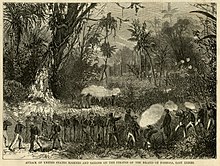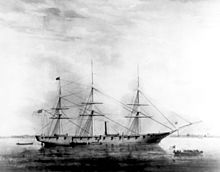American punitive expedition to Formosa in 1867
In June 1867, US Navy units undertook a punitive expedition to Formosa . The expedition was in retaliation for the killing of American sailors by Formosan natives in March of that year.
Rover incident
On March 12, 1867, the American merchant ship Rover ran onto a coral reef near Cape Eluanbi , on the southern tip of the island of Taiwan (then Formosa ). The ship had left the port of Shantou (then Romanized: Swatow ) in southern China on March 9, 1867 and was on its way to Yingkou (then known as Newschwang ) in northern China. The ship was able to detach itself from the reef, but could no longer be saved, so the crew went into the two dinghies. The captain, his wife, a sailor and 6 Chinese boarded a boat and another sailor boarded the second boat with 7 Chinese. Both boats rowed towards the mainland, but were separated in the dark. The first boat reached the bank after several hours, where the castaways initially rested. After about half an hour they were suddenly shot at from an ambush. A Chinese could escape and hide in the dark. After several hours of hiking through the mountains, he reached a Chinese settlement, from where he embarked for Takow (today: Kaohsiung ). There he arrived on March 22, 1867 and reported on the events. The British ship HMS Cormorant , lying in the port of Takow, then sailed towards the east coast from March 25, 1867 in order to rescue any survivors or to investigate their fate. The British consul in charge of Formosa was also on board. On March 26, 1867, several men of the crew of the Cormorant went ashore at the boat landing site. Something similar happened again and the men who had landed were shot at from an ambush, so that they quickly retreated towards the ship. Several volleys were fired from the ship into the surrounding bushes, whereupon numerous natives who had hidden there came out, some of them returned fire and some of them fled into the hinterland. The crew of the HMS Cormorant saw their fears confirmed that the shipwrecked rovers had apparently been killed by the local natives of the Paiwan tribe , who were known as headhunters .
In previous years, numerous ships along the south and east coasts of Formosa had capsized or disappeared, and the fate of the crews remained largely unclear. Individual survivors later emerged and reported that they had been imprisoned and kept as slaves by the native population on the Formosa coast. In 1860 the transport ship Elbe , a ship in the service of the Prussian East Asia Expedition, had explored the south and east coast of Formosa and dropped a few sailors ashore to explore the country. These were immediately attacked and shot at by the natives, after which the Prussian commander went over to the counterattack and had a natives' settlement destroyed. This was the first systematic punitive action against the natives.
American punitive expedition 1867

The island of Formosa (Taiwan) was formally part of the Chinese Empire at that time . After the incident became known, the US consul in Amoy ( Xiamen ), Charles Le Gendre, went to the Chinese governor-general of Fujian Province (to which Formosa belonged) and urged him to do something about the matter. He stated that the natives of Formosa did not obey the laws of China. Le Gendre then traveled personally to Formosa, where he tried unsuccessfully to persuade the Chinese prefect of Formosa to act against the natives. Nor was it possible for him to enter into direct negotiations with the natives.
The American government (then under President Andrew Johnson ) decided to send a punitive expedition against the "savage savages". Two ships, the Hertford and the Wyoming under the command of Captain Belknap with a crew of 181 officers, sailors and marines were equipped and the force landed on June 19, 1867 on the Formosa coast. Here the Americans moved inland but encountered considerable difficulties. They were ambushed by the natives and the unfamiliar tropical climate was a heavy burden on the men. There was hardly any progress through the thick jungle. Ultimately, while leading an uphill attack, the senior officer was also killed. After a certain period of time, the Americans had to retreat to their ships in some disorder.
After this first, less successful undertaking, there was a second action in September 1867, led by Charles Le Gendre as the commander. This second force consisted largely of Chinese provided by the Chinese government. This troop moved inland to the Paiwan settlement area, where Le Gendre entered into negotiations with the Paiwan chief without major fighting and concluded an agreement in which the Paiwan pledged to stop attacking shipwrecked people and To undertake seafarers.
The Paiwan pacification thus negotiated was short-lived. In the so-called Mudan Incident in 1871, dozens of shipwrecked Japanese fishermen were killed by the Paiwan, which led to a Japanese punitive expedition in 1874.
Individual evidence
- ↑ a b Wreck of the Barque Rover . In: Timaru Herald . tape VII , no. 221 , July 10, 1867, p. 3 (English, online ).
- ↑ a b c d James W. Davidson: The Island of Formosa, Past and Present: history, people, resources, and commercial prospects: tea, camphor, sugar, gold, coal, sulfur, economical plants, and other productions . Macmillan, London and New York 1903, pp. 115-122 (English, online ).
